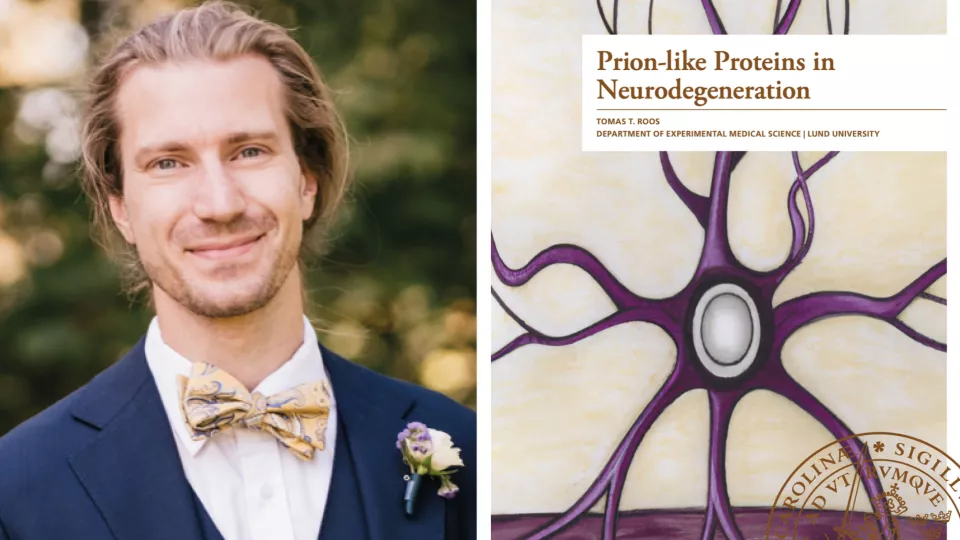Tell us about your research!
“The majority of researchers agree that Amyloid-beta (Abeta) matters for Alzheimer’s disease. The Abeta plaques are a pathological hallmark of Alzheimer’s disease, Abeta is the first biomarker that is altered, heritable forms of Alzheimer’s rely on mutations in the Abeta protein* or enzymes involved in its production, and a mutation that reduces Abeta production protects against AD. Still, Abeta plaques do not correlate to cognitive decline and removing plaques have not improved symptoms in clinical trials. It seems like we have missed something. And we think that this missing piece is the location and initial source of aggregated Abeta.
Chemically, what makes Abeta prone to aggregate is when the concentration of the molecules is high and the pH is rather low. We find this environment inside neurons, specifically in subcellular compartments called endosomes/lysosomes. There is also a hypothesis that Abeta aggregates can spread in a prion-like way. Meaning that Abeta can misfold/aggregate in a specific way where the misfolded Abeta can induce healthy Abeta to also misfold, thereby spreading the disease throughout the brain. Thus, we suspected that this prion-like Abeta could originate within cells and that this would be one of the earliest steps in the pathogenesis of AD. So, we looked for aggregation there at very early time points before any plaques were formed outside the neurons. We looked at this both in cultured cell lines as well as in mouse models carrying mutations in the Abeta gene.”
* Some of you may be annoyed by the fact I call Abeta a protein, and yes, indeed, it is a peptide, but let’s just simplify it, calling it a protein for now.
And what did you find?
First, we showed that one could induce the formation of prion-like Abeta inside a cell, something that had never been shown before. We then looked in mice with AD mutations where we also had accelerated the Abeta aggregation and found lots of aggregated Abeta inside the neurons at the first time points. But as soon as the Abeta plaques started to accumulate outside the neurons, these pools of aggregated Abeta inside the neurons almost disappeared. This surprised us.”
Why do you think the aggregations inside the neurons disappeared when the plaques developed?
“It may be some kind of equilibrium between the in- and outside of the cells. Initially, before plaques are formed, the neurons may just overproduce Abeta and this leads to aggregation inside the cells. Later, when Abeta also accumulates in critical amounts outside the cells, this may suck out the internal Abeta, like osmosis of molecules over a membrane to have equal concentrations on both sides. However, we are not certain yet if this is the driving force behind what we see, although it is a plausible explanation.”
As plaques drain out the aggregates formed inside the cell, then plaques are beneficial?
“Not really. We also detected increased production of Abeta in the neurons when their internal pool was diminished; it was like turning on a tap. Hence, plaques sucking Abeta out of the cells may trigger even more production of that protein in a vicious cycle. This could partly explain the enormous increase of Abeta in the AD-afflicted brain ”
So, you think that aggregation of Abeta inside the neurons may be essential for Alzheimer’s pathology, but how do prion-like properties come into the picture, as the title of your thesis indicates?
“Prion-like spread means that a malformed protein, like Abeta, may serve as a template for disturbing the conformation of normally folded versions of that protein. This, in turn, becomes an additional template that can misfold even more Abeta molecules that were initially normal. When Abeta becomes misfolded it will more easily aggregate. Like that, the amount of aggregated Abeta increases exponentially.
We crushed brain tissue from Alzheimer’s mice containing pathological Abeta. When we injected this into the brain of anesthetized mice, it sped up the formation of plaques. The pathological Abeta also spread to neurons in a brain region far from the injection site. This brain region contained neurons that were connected to other neurons near the injection site. Taken together, our experiments suggest that Abeta accumulation inside neurons is of pathological importance and that it may spread from cell to cell across the brain.”
Your experiments suggests that Abeta accumulation starts inside the neurons and spreads across neurons. What about other brain cells?
“Microglia are capable of engulfing Abeta and are mobile cells in pathological conditions, so they may contribute to spreading it elsewhere if they cannot break it down. But I don't think they initiate the spread.”
You work as a physician. Why do you choose to do experimental research? Do your findings matter to patients?
“Despite extensive clinical trials with antibodies reducing the plaques, we still lack treatment that actually cures or at least halts Alzheimer’s disease. I think these failures are because we still lack fundamental knowledge about what initiates and drives the disease progression. We probably targeted the wrong form of Abeta with our drugs. Maybe, we need to combine the plaque-reducing antibody treatments with something that lowers Abeta inside the cells. This is of course tricky, as Abeta most likely also have physiological functions at normal levels and conformations.”
Why does it matter whether the accumulation starts inside or outside the neuron?
“You need to know where and what to target to treat patients early on, before neurons start to die.”
Being the only MD doing experimental research at MultiPark, how has it been combining experimental and clinical work?
”Experimental research takes longer time and is less flexible compared to, for example, register studies. But I am convinced that it is necessary to be able to develop treatments for these patients. And motivation is important.”
Can you tell us more about the cover of your thesis?
“As I am a great fan of Hilma Af Klint’s paintings, I instructed an AI program to produce a picture of a neuron based on her style.”
How did you end up at MultiPark?
“I got inspired by Patrik Brundin’s (among those who initiated MultiPark) research during a lecture at the basic medical education. He looked into the prion-like spread of alpha-synuclein, a protein linked to Parkinson’s disease. So, I started with that project, which turned out to be the first paper in my thesis. As he moved his lab to the US and I wanted to stay in Sweden, he put me in contact with Gunnar Gouras, who worked on intraneuronal Abeta and, at that time, was recently recruited to MultiPark. So then, I shifted focus to Abeta and Alzheimer’s instead, still investigating similar mechanisms.”
What did you like the most during your thesis work at MultiPark?
“The retreats have been lovely!”
What have been the most challenging during your Ph.D.?
”To combine experimental work with clinical duties and family life.”
And the most rewarding?
”To make discoveries that may be relevant to finding cures. I especially remember the first time I looked at my induced prion-like cells in the microscope and realized that my experiments worked.”
What are you most proud of?
“To contribute to increased knowledge.”
What do you like to do when you are not at work?
”I spend much time with my family, and like to read, preferably about history.”
What advice do you want to give to new Ph.D. students?
”Work with something that you are really interested in.”
What happens after your defense?
”I have research funding until the end of the year, so far. After that, I will see, but my goal is to continue with academic research. Our second daughter will also soon be born.”



